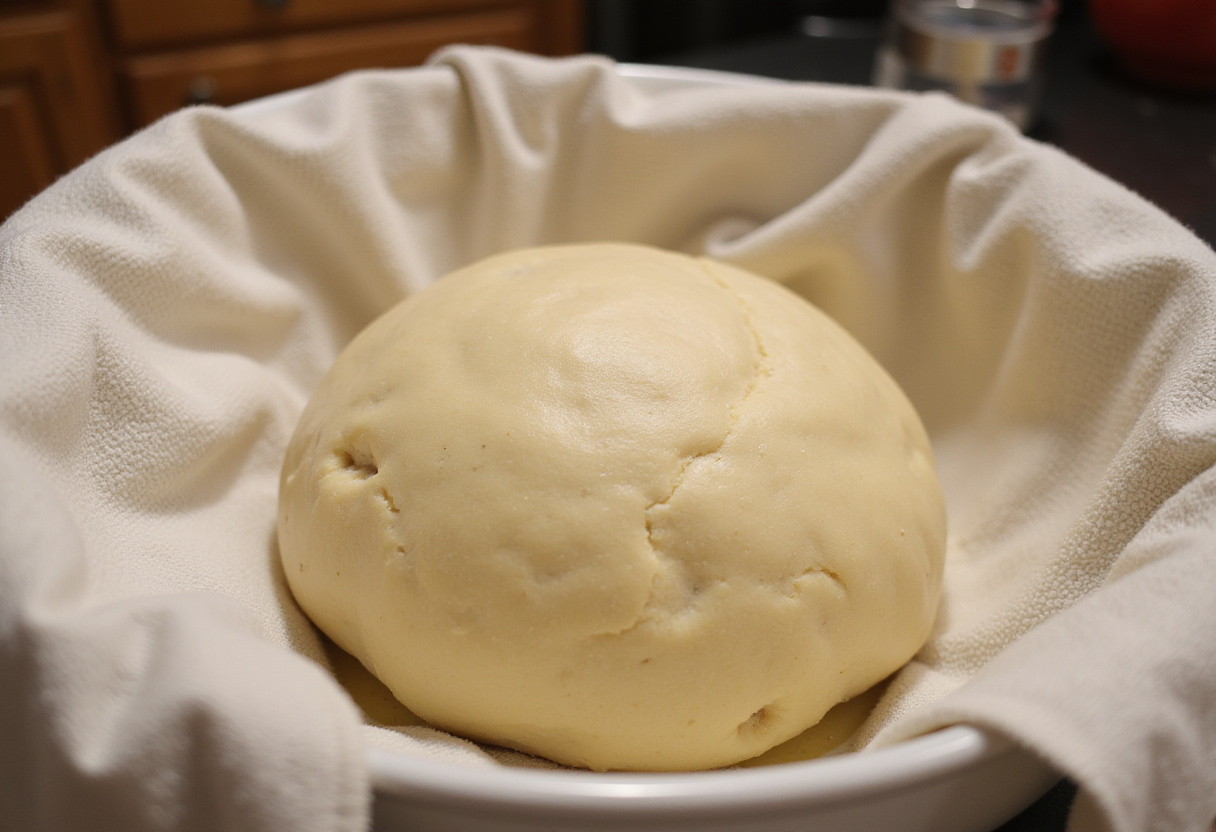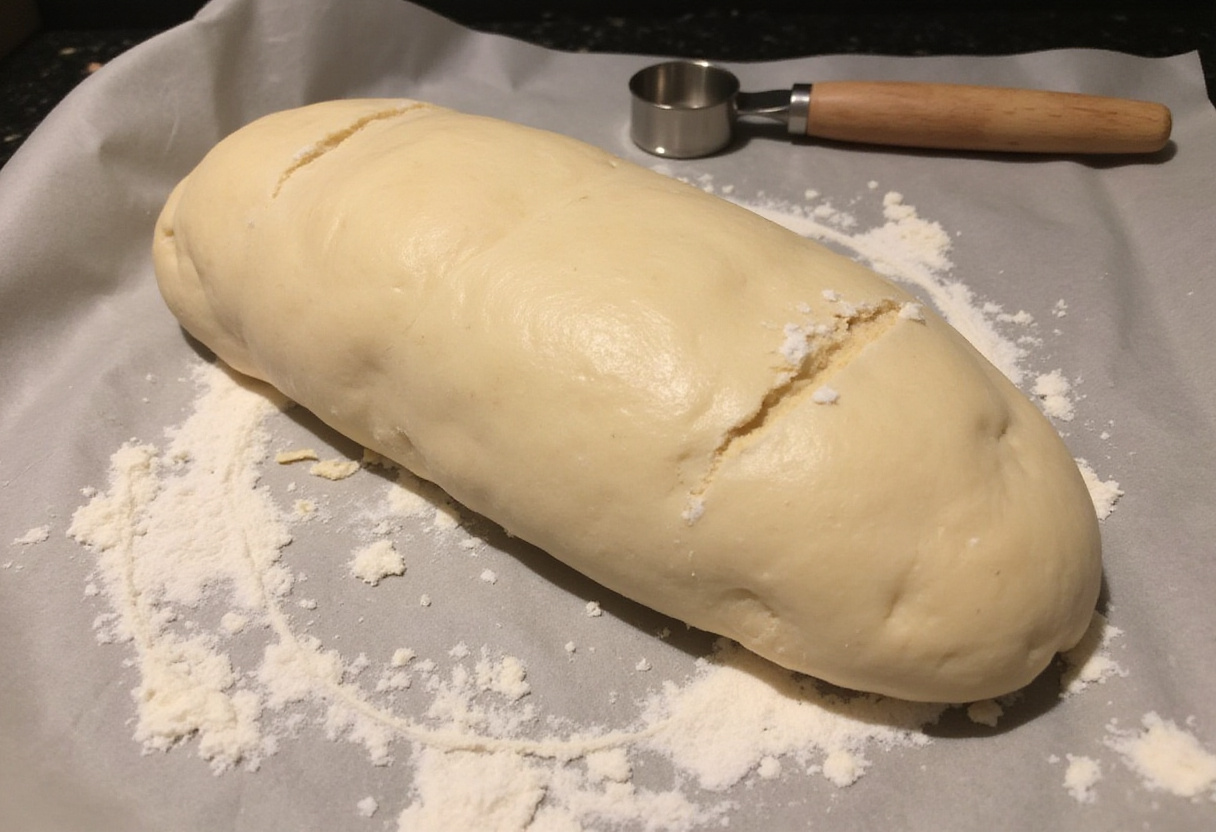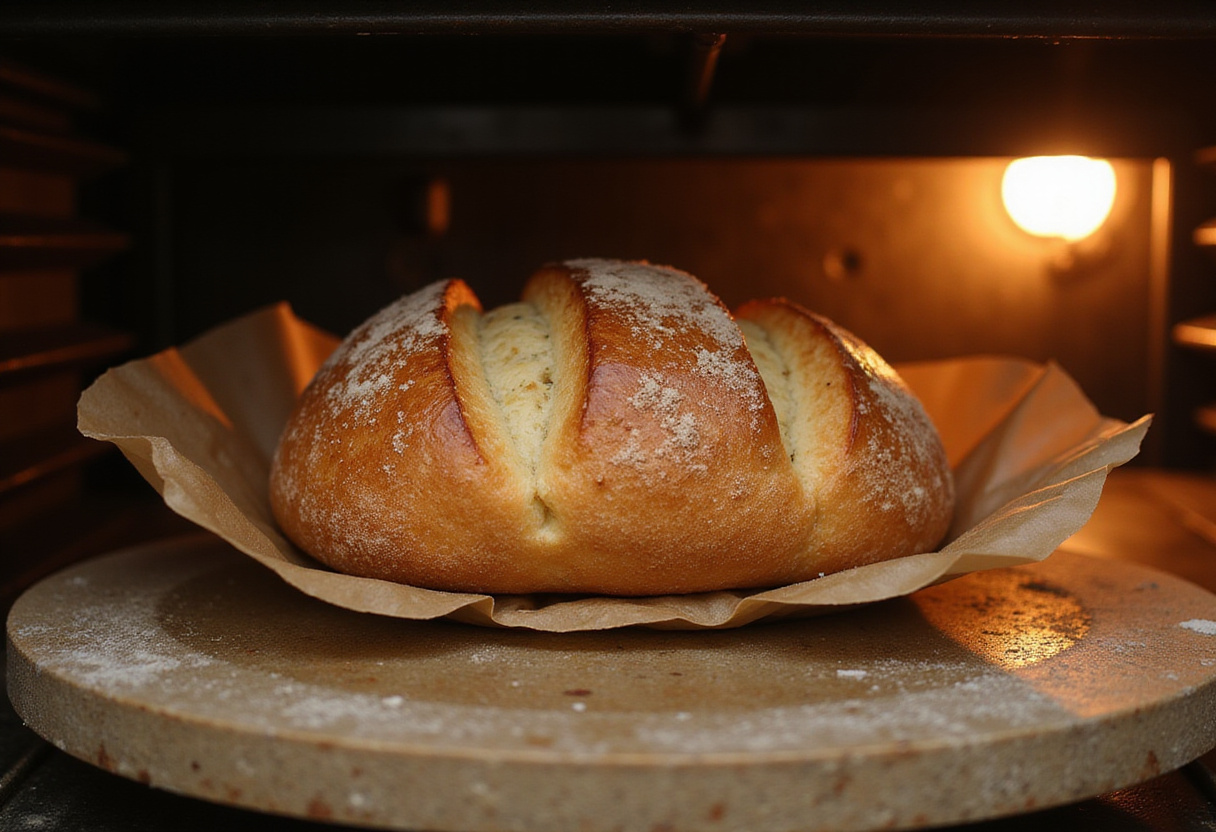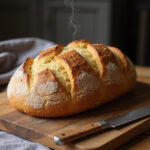Classic Style Batard Bread You Can’t Resist: A Crusty, Flavorful Dream 🥖🌾🌟
1. Introduction
There’s nothing quite like the aroma of freshly baked bread wafting through your home. It’s a sensory experience that evokes feelings of warmth, comfort, and satisfaction. Today, we’re diving into the world of artisan baking with a batard bread recipe that’s sure to impress your family and friends. A homemade batard, with its characteristic elongated shape and delightful crust, is a testament to the simple beauty of flour, water, yeast, and salt. It’s amazing how these humble ingredients can transform into something so extraordinary! This classic bread baking guide will walk you through each step, ensuring you create a classic style batard bread that you simply can’t resist. We’ll explore the nuances of fermentation, shaping, and baking to help you achieve that perfect golden crust and airy crumb. Whether you’re a seasoned baker looking to refine your skills or just starting and eager to learn, this recipe is designed to bring the joy of an artisan bread recipe right to your kitchen. Let’s get started and bake a loaf that will be the star of your next meal! Imagine serving this alongside a hearty bowl of soup from our soups category!

2. Understanding Batard Bread
Before we dive into the details of this batard bread recipe, let’s understand what makes a batard special. Understanding the history and characteristics of this bread will give you a greater appreciation for the baking process. A batard is a type of French bread, similar to a baguette but shorter and plumper. Think of it as the baguette’s more relaxed cousin! Its unique shape allows for a wonderful balance of crust and crumb, making it incredibly versatile. It’s perfect for sandwiches, dipping in olive oil (perhaps as part of an appetizer spread? Check out our appetizers and snacks section for inspiration!), or enjoying on its own with a smear of butter. Embarking on this classic bread baking adventure means embracing simplicity and patience, resulting in an exceptional homemade batard. It’s about savoring the process and enjoying the rewards of your labor.
3. Ingredients for the Perfect Batard
To bake a truly irresistible classic style batard bread, you’ll need just a few high-quality ingredients. Sourcing the best ingredients you can find will make a noticeable difference in the final product. Consider using organic flour and filtered water for the purest flavor.
- 3 1/2 cups (420g) bread flour: Bread flour is essential because it contains a higher protein content, which helps develop the gluten structure needed for a chewy and airy bread.
- 1 3/4 cups (420ml) warm water (about 105-115°F or 40-46°C): The temperature of the water is crucial. Too cold, and the yeast won’t activate; too hot, and you’ll kill the yeast.
- 2 teaspoons (6g) active dry yeast: Yeast is the magic ingredient that makes the bread rise. Make sure it’s fresh and active.
- 2 teaspoons (12g) salt: Salt not only adds flavor but also controls the yeast activity and strengthens the gluten structure.
These simple ingredients, when combined and treated with care, will transform into a magnificent artisan bread recipe. Always ensure your yeast is active for the best rise and flavor. To test your yeast, simply add it to the warm water with a pinch of sugar. If it foams up within 5-10 minutes, you’re good to go!
4. Step-by-Step Batard Bread Recipe
Mixing the Dough
In a large bowl, dissolve the yeast in warm water. Let it stand for 5 minutes until foamy. This step is like waking up the yeast! If it doesn’t foam, your yeast might be old. Add the flour and salt. Mix until a shaggy dough forms. Don’t worry about making it perfect at this stage; you just want the ingredients to come together. The journey to a perfect homemade batard begins here, with careful mixing to develop the gluten. If you love this type of recipes, explore more in our dinner ideas section.

First Rise (Bulk Fermentation)
Turn the dough out onto a lightly floured surface and knead for 5-7 minutes until smooth and elastic. Kneading develops the gluten, which gives the bread its structure. If you’re using a stand mixer, this process is even easier. Alternatively, mix in a stand mixer with a dough hook for 5-7 minutes. Place the dough in a lightly oiled bowl, turning to coat. This prevents the dough from drying out. Cover and let rise in a warm place for 1.5-2 hours, or until doubled in size. The warmer the environment, the faster the dough will rise. This rise is crucial for the flavour and texture of your classic style batard bread. As the yeast ferments, it produces carbon dioxide, which creates air pockets in the dough and contributes to its airy texture and wonderful flavour. Embrace the patience required for this stage when creating your batard bread recipe. It’s a testament to the slow food movement!

Shaping the Batard
Gently deflate the dough and turn it out onto a lightly floured surface. This step releases some of the gas and makes the dough easier to handle. Shape the dough into an oblong loaf, tapering the ends. There are many videos available online that demonstrate the proper shaping technique. This distinctive shape is what sets a homemade batard apart and makes it a proud accomplishment within the artisan bread recipe. It’s a fun and rewarding process that allows you to get hands-on with your dough. If you’re looking for something to serve with your fresh batard, why not try one of our delicious salads?

Baking to Perfection
Preheat your oven to 450°F (232°C) with a baking stone or Dutch oven inside. The high temperature is essential for creating a crispy crust. If you don’t have a baking stone or Dutch oven, you can use a regular baking sheet. Carefully transfer the shaped batard onto the hot baking stone or into the Dutch oven. Be careful not to burn yourself! Score the top of the loaf with a sharp knife or lame. Scoring allows the bread to expand properly in the oven. This step is vital for achieving the perfect crust on your classic style batard bread. Bake for 25-30 minutes, or until the crust is golden brown and the internal temperature reaches 200-210°F (93-99°C). Use a food thermometer to ensure the bread is fully cooked. When using a Dutch oven, bake covered for the first 20 minutes, which traps steam and creates a softer crumb, then uncovered for the remaining time to achieve a crispy crust.

5. Tips for a Perfect Crust and Crumb
Achieving that coveted crust and perfect crumb in your homemade batard involves a few key techniques. These techniques will help you consistently bake beautiful and delicious loaves of bread. For more inspiration and baking tips, you might find valuable insights on external resources like this detailed guide to Batard Bread. Firstly, ensure your oven is hot enough; preheating with a baking stone helps mimic a professional bread oven. A hot oven provides the initial burst of heat needed for optimal rise and crust formation. Secondly, scoring the dough properly allows for controlled expansion during baking, preventing unsightly tears and ensuring an even rise. Experiment with different scoring patterns to create unique and beautiful loaves. Finally, don’t be afraid to experiment with steam – a little extra humidity in the oven during the initial baking phase can contribute to a crispier crust. You can achieve this by placing a pan of hot water on the bottom rack of your oven. Mastering these nuances is what elevates an artisan bread recipe to another level. It’s about paying attention to detail and understanding the science behind baking.
6. Variations on the Classic Batard Bread Recipe
Once you’ve mastered the basic batard bread recipe, feel free to experiment with different flavors and ingredients. The possibilities are endless! Get creative and have fun with it. You might want to check our breakfast and brunch category for ideas on how to use your batard! Try adding herbs like rosemary or thyme for an aromatic twist, or incorporate olives or sun-dried tomatoes for a savory loaf. You can also play with different types of flour, such as whole wheat or rye, to add depth and complexity to the flavor. Each type of flour will impart a unique flavor and texture to the bread. These variations make your classic style batard bread truly unique.
7. Serving Suggestions
A freshly baked classic style batard bread is incredibly versatile. Its neutral flavor pairs well with a wide range of foods. Serve it warm with butter or olive oil for a simple yet satisfying treat. A slice of warm batard with a drizzle of olive oil and a sprinkle of sea salt is pure bliss. Use it to make gourmet sandwiches with your favorite fillings. Think roast beef with caramelized onions, or grilled vegetables with pesto. It’s also the perfect accompaniment to soups, stews, and salads. Use it to soak up the delicious broth or dressing. The possibilities are endless with this delightful homemade batard.
8. Troubleshooting Common Batard Baking Issues
Even experienced bakers can encounter challenges. Don’t get discouraged if your first few loaves aren’t perfect. Baking is a learning process! If your batard bread recipe isn’t rising as expected, check the expiration date of your yeast and ensure the water isn’t too hot (which can kill the yeast). Also, make sure your kitchen isn’t too cold. A dense crumb can often be attributed to under-proofing or not kneading the dough enough. Give the dough enough time to rise, and make sure you develop the gluten properly. A pale crust might indicate insufficient oven temperature or a lack of steam. Use an oven thermometer to ensure your oven is at the correct temperature, and try adding a pan of hot water to create steam. Addressing these issues will improve you artisan bread recipe creations. And if things go completely wrong, remember that even mistakes can be delicious! Why not take a look at our About us page for contact information.
9. Conclusion
Baking a classic style batard bread is a rewarding experience that brings the simple pleasures of fresh, homemade batard right to your table. This batard bread recipe, with its straightforward steps and readily available ingredients, is an excellent starting point for anyone looking to explore the world of artisan bread recipe. It’s a journey that will fill your home with wonderful aromas and provide you with the satisfaction of creating something truly special. So, preheat your oven, gather your ingredients, and embark on this delicious journey. If you are intrested in main dishes You can check our Main Dishes category.. Happy baking!
Print
Classic Style Batard Bread You Can’t Resist
- Total Time: 2 hours 50 minutes
- Yield: 1 loaf 1x
- Diet: Vegetarian
Description
Classic Style Batard Bread You Can’t Resist is a crusty, flavorful bread that brings the joy of artisan baking right to your kitchen. Perfect for sandwiches, dips, or enjoying fresh, this homemade bread is a culinary masterpiece with a delightful crust and crumb.
Ingredients
- 3 1/2 cups (420g) bread flour
- 1 3/4 cups (420ml) warm water (about 105-115°F or 40-46°C)
- 2 teaspoons (6g) active dry yeast
- 2 teaspoons (12g) salt
Instructions
- Dissolve the yeast in warm water and let it stand for 5 minutes until foamy.
- Add flour and salt, mixing until a shaggy dough forms.
- Knead for 5-7 minutes until smooth and elastic.
- Let the dough rise in a lightly oiled bowl for 1.5-2 hours or until doubled in size.
- Shape the dough into an oblong loaf, tapering the ends.
- Preheat your oven to 450°F (232°C) with a baking stone or Dutch oven inside.
- Transfer the shaped batard to a hot surface and score the top with a sharp knife.
- Bake for 25-30 minutes until the crust is golden brown and the internal temperature is 200-210°F (93-99°C).
Notes
- Ensure your yeast is active for the best rise.
- For a crispier crust, incorporate steam in the oven during baking.
- Experiment with flavors and ingredients such as herbs or olives for unique variations.
- Prep Time: 20 minutes
- Cook Time: 30 minutes
- Category: Bread
- Method: Baking
- Cuisine: French
Nutrition
- Serving Size: 1 slice
- Calories: 120 Kcal
- Sugar: 0g
- Sodium: 300mg
- Fat: 1g
- Saturated Fat: 0g
- Unsaturated Fat: 0g
- Trans Fat: 0g
- Carbohydrates: 24g
- Fiber: 1g
- Protein: 4g
- Cholesterol: 0mg



